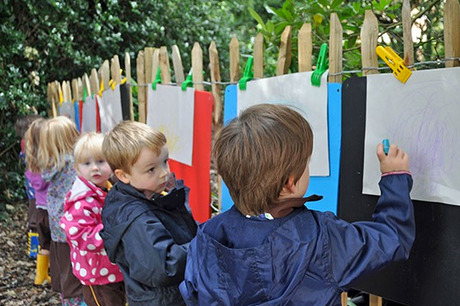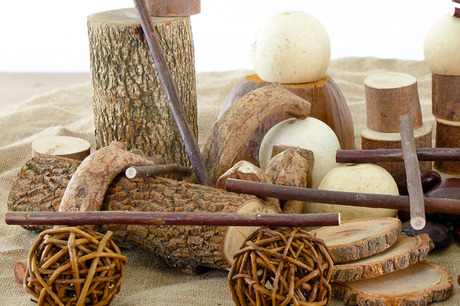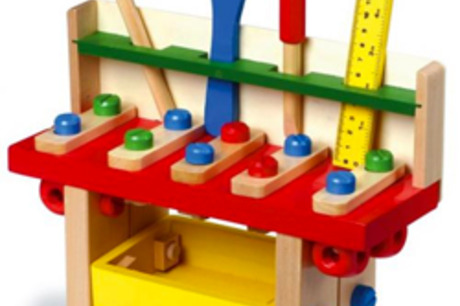learning, but how can practitioners support children's creativity and
understanding? Nicole Weinstein explains.

EYFS: Exploring and using media and materials: children sing songs, make music and dance, and experiment with ways of changing them. They safely use and investigate a variety of materials, tools and techniques, experimenting with colour, design, texture, form and function
Creative Development seemed to become a whole lot more complicated under the revised Early Years Foundation Stage (EYFS). First, there was the name change - to Expressive Arts and Design - which left practitioners feeling uncertain about what this actually meant. Then, as if it was not big enough already, Design and Technology was moved into this area of learning from Knowledge and Understanding of the World. The early learning goal 'Being creative' was removed to become a characteristic of effective learning - 'Creating and thinking critically'. And finally the goals for this area of learning were condensed into two aspects, adding little clarity in the process.
The overarching theme for the first aspect is 'Exploring and using media and materials', and within that is the requirement that practitioners provide opportunities for children to explore 'form and function'.
Talking about the changes, early years and creative arts consultant, Anni McTavish explains, 'In the first instance, one of the main issues that practitioners face is the wide range of areas they should be covering in Expressive Arts and Design because there are quite a lot. Media and materials includes all the visual arts - mark-making and drawing, paint, collage, weaving, photography, and the performing arts - movement, action rhymes, songs and music. Practitioners also need to think about malleable materials like clay, playdough, 3D and sculpture. This includes treasure baskets and heuristic play, transient - moveable - art and found materials, for example, cardboard boxes, milk crates, fabric pieces and guttering for outdoor play.'
Combining all these media can be quite difficult if practitioners lack confidence or have little personal experience or practice with the arts, believes Ms McTavish. She explains, 'This is an important area of learning and development, and practitioners need support, training and guidance, as well as time to talk and discuss ideas or concerns. Some settings have worked hard to develop practice that is exciting and innovative.
'But from my experience, adults also need the chance to express their creativity, and the opportunity to explore media and materials and try out art experiences themselves, before being expected to teach children to do so. At the end of the day, if the adults are not inspired, the children are unlikely to be.'
For inspiration, and to build on children's interests and creativity, practitioners can view artists' work in books, visit galleries and look at interesting sculptures and architecture. However, opportunities for artistic exploration can also be found in the simplest of activities. Ms McTavish adds, 'Just taking time with a small group of two-year-olds to look at leaves - the texture, the pattern, shape and colour, the feel and the sound - is teaching exploring media and materials and artistic appreciation.'
FORM AND FUNCTION
So how can practitioners support children's understanding of 'form and function' within this?
In the world of art, 'form' refers to a three-dimensional geometrical figure (such as a sphere, cube or cylinder), as opposed to a two-dimensional shape (such as a square, circle, or oblong). But when it comes to very young children - and the area of Expressive Arts and Design - 'form and function' relates to all children's artistic and design endeavours, in 2D or 3D. Anni McTavish explains that:
- form relates to the decisions made when creating something, practical and/or decorative, and so would include making choices about materials, size, shape, dimensions, colour and texture
- function relates to how effective the choices have been in making the object fit for purpose.
She adds, 'The meaning of form and function in the context of the revised EYFS under media and materials is not only about shape and how the creation looks but the choice of materials, how these can be used and if something actually works and is fit for purpose.'
A simple example of exploring form and function would be to unpick an envelope or cereal packet to consider the choices involved in creating. However, Ms McTavish also recalls an excellent example in which a child at Sheringham Nursery School, in east London, used a range of tools and materials to experiment with form and function, in both two and three dimensions:
The boy, aged four, decided that he wanted to make an anchor. He had seen an image of a boat on a poster about pirates and this had sparked his idea. He was interested in the shape of the anchor, and what it did and he wanted to represent it. He drew it on a piece of paper and then cut it out. A practitioner encouraged him to think about what the anchor did and what he could do next. He decided to make a boat out of cardboard. He drew the outline of a boat, paying particular attention to its form, and asked for help to cut it out. The anchor was quite large but he decided to make the boat bigger than the anchor and selected materials to attach the anchor to the boat. He chose string and strengthened this join with coloured Sellotape. All the time, he was thinking about the form of the boat and was interested in the function of the anchor. His design made sense to him about how a boat and anchor should look.
Designing and making feature far beyond the arts workshop area, however. Ms McTavish explains, 'Some practitioners may not realise that children are designing and making as they are exploring block play or large-scale construction outdoors, and even things like creating a sandwich, or treasure basket play, which link to the prime areas of learning, are elements of this.'
IN PRACTICE
To support children's explorations of media and materials in 2D and 3D, and within that 'form and function', practitioners should provide lots of interesting materials and tools with a real focus on natural, open-ended materials.
Ms McTavish says, 'One way to support this is to provide a rich variety of transient art materials: materials that are designed to be movable and can be used indoors and out. Indoors, there could be "no glue art", where children use natural and found materials to create 3D sculptures that can be taken apart.'
Materials for outdoors can be bigger and heavier and might include pebbles, small off-cuts of wood, lengths of stick, cardboard boxes or tyres. The short film 'Scrapstore Playpods - Early Years' on YouTube shows some inspiring ideas for the use of found materials (www.youtube.com/watch?v=laFA9QqPP14).
Whether indoors or out, children should always be allowed plenty of time to explore materials, with, as appropriate, adult support and some adult-guided experiences.
So, for example, a practitioner might model ways to use particular media or support and guide a child to use scissors correctly or use techniques such as 'stippling' (dabbing up and down quickly) using a sponge or a brush when painting. It is about learning how to use the tools and techniques and media and then supporting the children to use these creatively and imaginatively.
This requires practitioners to pay particular heed to their continuous provision and how to build on children's current interests. For example, are there large and small blocks? Is there a well-resourced junk modelling and workshop area? Are there tools in it that work - do the scissors cut? Is there string, pieces of rope, tape, Sellotape dispensers, runny glue and glue sticks? Are children able to transport materials to make and create 3D art?
Vital to the whole process, however, is the need for practitioners to support and enable children's critical thinking abilities, provide appropriate language and encourage them to think about what they have created.
Ms McTavish says, 'Dialogue is really important; you might talk about how something the children have made might work, the process of making, or how they might be able to improve their design, so that it can work better. It may also involve encouraging children to formulate their own questions, be innovative and find solutions to problems.'
Here are some examples of resources to enable children to be creative, design and make in 2D and 3D.
PAINTING, DRAWING AND COLLAGE

Offer children a variety of painting and mark-making activities on a daily basis. This should be predominantly child led and children allowed to explore and experiment with colour and texture with the emphasis on process not product.
Combine different materials with paint such as glue, cornflour, shaving foam and salt to explore how it changes the effects. Similarly, explore different paints from water colours - try the Brusho powders as a cheaper alternative to liquid watercolours, powder paints, diluted food colouring, metallic paint, fabric dye and marbling inks. Provide a range of tools that children can squeeze, such as spray bottles, pipettes, basters and squeezy bottles.
Best buys
Brushes and Mark Makers (15 pack for £15), Brush Painters (£8), Rollers on Poles (£10.99), Easy Grip Pattern Makers (£2.99), Brusho Liquid Watercolours (£12.95), Painting Mits (£13.99), Compact Hand Sprayers (£5.49), Paint Squirt Bottles (£1.99), Paint Sprayer (£1.50), Playground Chalk (£3.75), Blackboard Paint (£10.95), Value Art Easel Boards (six pack, £20.69), Giant Art Canvas (£18.99), Self Draining Fence Easel (£29.99), Small Clear Perspex for Round Table (£25.49), Art Spinner (£6.99), Pendulum Painter (£27.99), Easy Squeezy Set (£22.99), all from Cosy Direct, at www.cosydirect.com or on 01332 370152.
3D Paint - Malibu Colours (£4.95), Wesco Modelling Clay, (£49.50), Cutting Tools (£13.50), all from www.wesco-eshop.co.uk.
Easy Grip Stampers (£29.99), Domed and Animal Rockers Set (£9.99), Wiggly Eyes Stack Pack - Coloured (£5.49), all from www.hope-education.co.uk.
Window Markers (£3), Fingerpaint Textures (£25.50), Crayon Eggs (£3.21), and Butterfly Boxes, a simple box folding activity designed to demonstrate the concept of transforming 2D objects into 3D ones (£7.95), from www.ypo.co.uk.
Table Top Painting Easel (£79.95), Finger Paint (£7.50), Wax Crayons Triangles (£4.99), all from www.thechildmindingshop.co.uk.
MALLEABLE MODELLING
Modelling can involve a wide range of materials from found and recycled items such as cardboard boxes and empty packaging to malleable materials such as clay, playdough and polymer materials. Provide different ways of combining and joining elements together (such as tape, string, glue, hole punches, split pins and elastic bands) for experimentation and to develop perseverance.
Best buys
Dough Face (£11.95), Air Hardening Clay (£3.60), Rainbow Swamp Gel (£11.99), Playfoam (£7.49), Building Noodles Jumbo Starter Pack (£5.99), Wooden Pattern Hammers (£5.95), Metal Craft Scissors (£5.95), Super Tough Cloth Tape (£5.95), Large Masking Tape (£1.80), Coloured Gaffa Tape (£5.95), Giant Rubber Bands (£5.75), Ball of String (99p), all from Cosy Direct.
ENVIRONMENTAL AND LOOSE PARTS ART

Explore patterns in natural and found objects, and create natural sculptures and collages. Use clay to make sculptures with feathers, sticks, leaves, stones and shells or make collages and Andy Goldsworthy-inspired pieces.
Best buys
Nature Keepers (£24.99), Flower Press (£6.95), Deco Pens (£8.50), Scottish Beach Cobbles (£9.99), Giant Picture Frame (£72.99), Natural Frames (£6.99), Blue, clear and green glass nuggets (£9.99), Mosaic Paths (£9.99), Shell Net Bag (£4.49), Maths Cone Selection (£4.50), all from Cosy.
Fabric Offcuts Assorted 250g (£7.99), Feathers Assorted 225g (£8.99), Textured Fabric Bundle - Pack 26 (£20.99), all from www.hope-education.co.uk.
Golden and Bronze Metallic Pebbles (£64.95), Treetop Village (£69.95), Natural Creative Set (£64.95), all from www.tts-group.co.uk.
Wooden Egg Cups (99p), from www.thechildmindingshop.co.uk
CONSTRUCTION AND WOODWORK

Construction play allows children to become engineers and designers as they plan, make and test their ideas.
Best buys
Treasure baskets and heuristic play support the exploration of a wide variety of materials and 2D and 3D shapes as children experiment with sensory-rich materials and objects. Try the Kasia Treasure Basket (£55) or the Collections range of resources (from £60 each), from www.playtoz.co.uk
Rustic Wood Treasure Basket (£47.95), Eco Building Logs (£74.99), Nature Building Blocks (£22.49), Giant Hollow Blocks (£387.50), 52-piece Hollow Block Set (£825), Building Block Cart (£224), Wooden Cotton Reels (£11.49), Thin Bamboo Columns (£10.25), Newspaper Builders (£37.59), Giant Tap Tap (£17.95), Woodwork Bench (£189), Hammering/Tinkering Block (£9.99), Real Woodworkers Starter Kit (£29.99), all from Cosy.
Lumberjack Logs (£64.95), Giant Outdoor Hollow Blocks (from £199.95), Wooden Plank Collection (£99.95), Water World Channelling Set (£189.95), Brick Set (£249.80), all from www.tts-group.co.uk.
Wooden Tool Kit Set Toy Workbench (£19.95), and a selection of wooden blocks, www.thechildmindingshop.co.uk.
.
RECIPE FOR SPICY PLAYDOUGH (UNCOOKED)
Make this with your children so they can explore the ingredients.
Ingredients
2 cups plain flour
1/2 cup salt
2 tablespoons cream of tartar
2 tablespoons vegetable oil
1 tsp each of ground cinnamon, coriander, cumin and cardamom
Up to 1.5 cups boiling water (add a bit at a time until it feels right)
food colouring (optional)
Method
Warm the vegetable oil on a low heat, add spices, mix and let sit for 10 minutes to infuse. If you can't warm the oil, add the spices, stir and let sit for 20 minutes.
Mix all the ingredients together in a large bowl
Check to make sure it is not too hot, knead with the children and it will be ready!
You could also make a photographic recipe book of this process for children to refer to.
MORE INFORMATION
Anni McTavish is an associate of Early Education and author of the forthcoming title, Expressive Arts and Design in the Early Years, due to be published by David Fulton.









